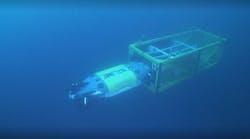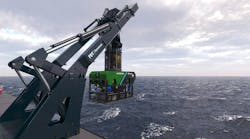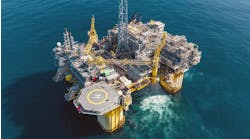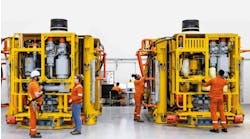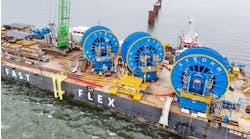Report: Sealien Robotics sells ‘deep-sea surveillance robot’ to Middle East buyer
In mid-March, the Chinese start-up company Sealien Robotics announced that it had sold one or more of its “deep-sea surveillance robots” to an unidentified Middle Eastern nation.
The deal was reported by the South China Morning Post. Details of the deal were scant, and little was known about the buyer’s intentions, but the implications for China’s rapidly growing deep-sea robotics market “could be immense,” the report commented.
Sealien Robotics, which produces a range of subsea inspection systems, markets those tools as machines that are designed as “tools of commerce,” according to the South China Morning Post. Their subsea systems are designed to inspect and help protect subsea cable and pipelines, and provide a range of subsea data gathering services.
But the report noted that “in sensitive regions, where a seabed trench might be claimed by more than one state, or an undersea cable transmits data vital to secret military activities, such deep-sea vehicles could play more than technical roles.”
In the Middle East, the nations of Iran, Saudi Arabia, Kuwait and Israel all maintain offshore energy facilities that require such technical surveillance systems.
Founded in 2021 and headquartered in the southern Chinese city of Guangzhou, Sealien Robotics “has grown rapidly,” the South China Morning Post noted. According to the company’s website, Sealien’s founding team consists of former engineers from a globally renowned European deep-sea robotics company.
The team is said to have “extensive experience” in the development of commercial-grade ROVs and has modelled its business strategy after American companies such as Oceaneering and Schilling Robotics.
As noted on its website, Sealien Robotics develops, manufactures and delivers a range of deep-sea robotic systems, including fully integrated deep-sea robots, subsea pipeline and cable-laying robots, ROV simulation platforms and deck inspection robots, while also offering leasing and spare parts services.
The company’s pipeline-laying robots are said to be capable of operating at depths down to 3,000 meters (9,843 feet) to install fiber-optic cables, power cables, umbilical cables and flexible pipelines, while its work-class deep-sea robots are said to be capable of functioning at depths down to 10,000 meters.
This is not Sealien’s first foray into the Middle Eastern market, the South China Morning Post noted. In December, the company supplied key components for a 4,000-meter water depth ROV to a leading service provider in the industry.
In addition, last May, as reported by Hong Kong’s “Beyond Headlines” website, Sealien completed the first offshore mission for Taurus, one of its subsea cable-laying robots that is said to be the largest of its kind in Asia. The project integrated the widely used “lay-then-bury” method in China’s unique maritime conditions.
Taurus has since been deployed on multiple offshore wind power projects, playing a key role in subsea cable installation. Advances in various types of intelligent subsea operational equipment such as Taurus “has enabled the rapid expansion of China’s offshore wind power sector,” the South China Morning Post report commented.
With the development of Taurus, the company said it hoped to inspire other Chinese firms to close the gap with global leaders in high-end marine engineering.
China has seen a surge in private companies entering the subsea equipment manufacturing sector in recent years, including SeaRobotix, under Hangzhou Aohai Ocean Engineering Technology; and Shenzhen QYSEA Tech.
These firms have been developing underwater robots and components for marine environmental surveys, biodiversity research, deep-sea mineral exploration, and other scientific expeditions, helping to expand China’s capabilities in ocean exploration and subsea operations.
The South China Morning Post report concluded: “The roles of private companies like Sealien [are] expected to grow, positioning them as key players in the global deep-sea robotics market as China continues to invest in ocean engineering and offshore energy development.”
Related content: ROVs

Bruce Beaubouef | Managing Editor
Bruce Beaubouef is Managing Editor for Offshore magazine. In that capacity, he plans and oversees content for the magazine; writes features on technologies and trends for the magazine; writes news updates for the website; creates and moderates topical webinars; and creates videos that focus on offshore oil and gas and renewable energies. Beaubouef has been in the oil and gas trade media for 25 years, starting out as Editor of Hart’s Pipeline Digest in 1998. From there, he went on to serve as Associate Editor for Pipe Line and Gas Industry for Gulf Publishing for four years before rejoining Hart Publications as Editor of PipeLine and Gas Technology in 2003. He joined Offshore magazine as Managing Editor in 2010, at that time owned by PennWell Corp. Beaubouef earned his Ph.D. at the University of Houston in 1997, and his dissertation was published in book form by Texas A&M University Press in September 2007 as The Strategic Petroleum Reserve: U.S. Energy Security and Oil Politics, 1975-2005.



